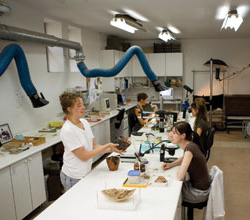Conserving the Athenian Past

Conservation Lab at the Athenian Agora
In 2006 the Conservation Department of the Agora Excavations accomplished its usual busy workload with the assistance of several new staff members. Karen Lovén replaced Assistant Conservator Claudia Chemello in May; after graduating with an M.Sc. in conservation from the University of London in September 2005, she first worked as the conservator for a marine archaeological excavation in Greece before joining the Agora Conservation Lab as a volunteer in January. Cherkea Howery joined the conservation team in August, replacing Clare Pickersgill, now Assistant Director of Archaeological Museums in Newcastle upon Tyne. Cher earned an M.A. in Mediterranean archaeology from the University of Bristol, UK, in 2005. Her main goal was to finish the re-housing and recording of the Agora’s ca.75,000 coins. We would also like to acknowledge Chryssanthi Papadopoulou, currently a first-year archaeology Ph.D. student at King’s College, who in recent years has been instrumental in assisting with the coin move and organizing our offprint files.
Our objective in the lab in early 2006 was to finish the conservation treatment of all 2005 finds by April, before the start of the following excavation season. We achieved our goal, apart from the silver hoard of around 400 tetradrachms, mentioned in the Winter/Spring 2006 issue of akoue. A treatment strategy is being developed for the silver tetradrachms by Head Conservator Amandina Anastassiades and Assistant Conservator Karen Lovén. The aim is to clarify the entire surface of the coins to enable numismatist Irini Marathaki to carry out a die study, which may allow her to put the coins into a production sequence. In collaboration with the National Centre for Scientific Research “Demokritos” we recently carried out preliminary analysis of the corrosion products and the silver alloy content on selected coins by x-ray fluorescence.
In a pleasant change of pace, the Conservation Department was involved in designing and installing a temporary exhibition of recent finds on the occasion of the 75th anniversary of the Agora Excavations and the 50th anniversary of the Stoa of Attalos. The artefacts were on display on the upper tier of the Stoa from June 15 through September 15, 2006, as part of a photographic exhibition prepared by Craig Mauzy recounting the history of the excavations and reconstruction of the Stoa.
As always, throughout the year, the conservation team assisted scholars from around the world in accessing the artefacts of the Agora collections. Often this involved examining the items in question to establish their condition, manufacturing techniques, or material composition. At other times, researchers requested artefacts be brought to the lab for stabilization, cleaning, and reconstruction. Over the past years, conservators also played a large role in preparing many of the ceramics to be included in John Hayes’ long-awaited publication on the typology of imported Roman pottery, Agora 32, due to be published in 2007.
The Conservation Department hosted three conservation interns in 2006. Sarah Allen (University of Lincoln, UK) joined us for six weeks in late spring. During the 2006 excavations eight-week internships were held by Jessica Chloros (University of Delaware) and Taryn Webb (Queen’s University, Canada). We are grateful to The Zibby Garnett Travelling Fellowship for generously funding our UK intern, and to the Samuel H. Kress Foundation for its generous support of the two North American students.
During the 2006 excavation our work focused on the newly recovered artefacts. Several finds of note that required special conservation attention included: a burial in a cracked Byzantine cooking pot, which conservators helped recover from the field; four pyres, together containing around 50 miniature vessels that Conservation is currently cleaning and reconstructing; two corroded silver drachma coins treated during the excavation; and a small pot containing a large iron nail as a lid. The pot oddly contained bird bones and is covered on the outside surface with inscribed letters and red pigment.
For the identification of bones and botanical specimens, we drew on the expertise of our colleagues from the Wiener Laboratory. Maria Liston (University of Waterloo) identified the human bones inside the Byzantine pot as the skeleton of a 32-week-old fetus. Archaeobotanist Evi Margaritis (Cambridge University) continues to analyze the charred remains discovered on dishes from one of this season’s pyre finds, and Doreen Spitzer Fellow Thanos Webb confirmed the bird bones found in the inscribed pot belong to a chicken.
Altogether, the 2006 excavations brought to light around 200 artefacts and around 205 copper alloy coins of which most had received conservation treatment before the beginning of the 2007 excavation season.